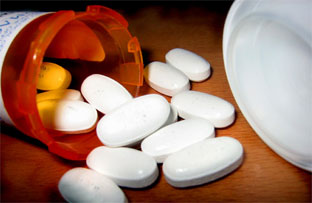|
Pharmacy Product Info » Famous Brand Names
Introduction to Drug Brands
Drugs often have several names. When a drug is first discovered, it is given a chemical name, which describes the atomic or molecular structure of the drug. The chemical name is thus usually too complex and awkward for general use. Next, a shorthand version of the chemical name or a code name (such as RU 486) is developed for easy reference among researchers.
When a drug is approved by the Food and Drug Administration (FDA the government agency responsible for ensuring that drugs marketed in the United States are safe and effective), it is given a generic name and a trade name. The trade name is developed by the company requesting approval for the drug and identifies it as the exclusive property of that company. For example, phenytoin some Trade Names DILANTIN is the generic name and Dilantin is a trade name for the same drug. When a drug is under patent protection, the company markets it under its trade name. When the drug is off-patent, the company may market its product under either the generic name or trade name. Other companies that file for approval to market the off-patent drug must use the same generic name but can create their own trade name. As a result, the same generic drug may be sold under either the generic name or one of many trade names.
In the United States, an official body the United States Adopted Names (USAN) Council assigns the generic name. The company that manufactures the drug develops the trade name. Generic and trade names must be unique to prevent one drug from being mistaken for another when drugs are prescribed and prescriptions are dispensed. To prevent this possible confusion, the FDA must agree to every proposed trade name.
Government officials, doctors, researchers, and others who write about the new compound use the drug's generic name because it refers to the drug itself, not to a particular company's brand of the drug or a specific product. However, doctors often use the trade name on prescriptions, because it is easier to remember and doctors usually learn about new drugs by the trade name.
Generic names are usually more complex and harder to remember than trade names. Many generic names are a shorthand version of the drug's chemical name, structure, or formula. In contrast, trade names are usually catchy, often related to the drug's intended use, and relatively easy to remember, so that doctors will prescribe the drug and consumers will look for it by name. Trade names often suggest characteristic of the drug. For example, Lopressor lowers blood pressure, Vivactil is an antidepressant that might make a person more vivacious, Glucotrol controls high blood sugar (glucose) levels, and Skelaxin relaxes skeletal muscles. Sometimes, the trade name is simply a shortened version of the drug's generic name for example, Minocin for minocycline.
 The term generic, when applied to such items as foods and household products, is used to describe a less expensive, sometimes less effective or lower-quality impressionist version of a trade-name product. However, most generic drugs, although less expensive than the comparable trade-name drug, are as effective and of the same quality as the trade-name drug. In fact, generic drug makers manufacture many trade-name products for companies that control the trade names. Sometimes, more than one generic version of a drug is available.
|